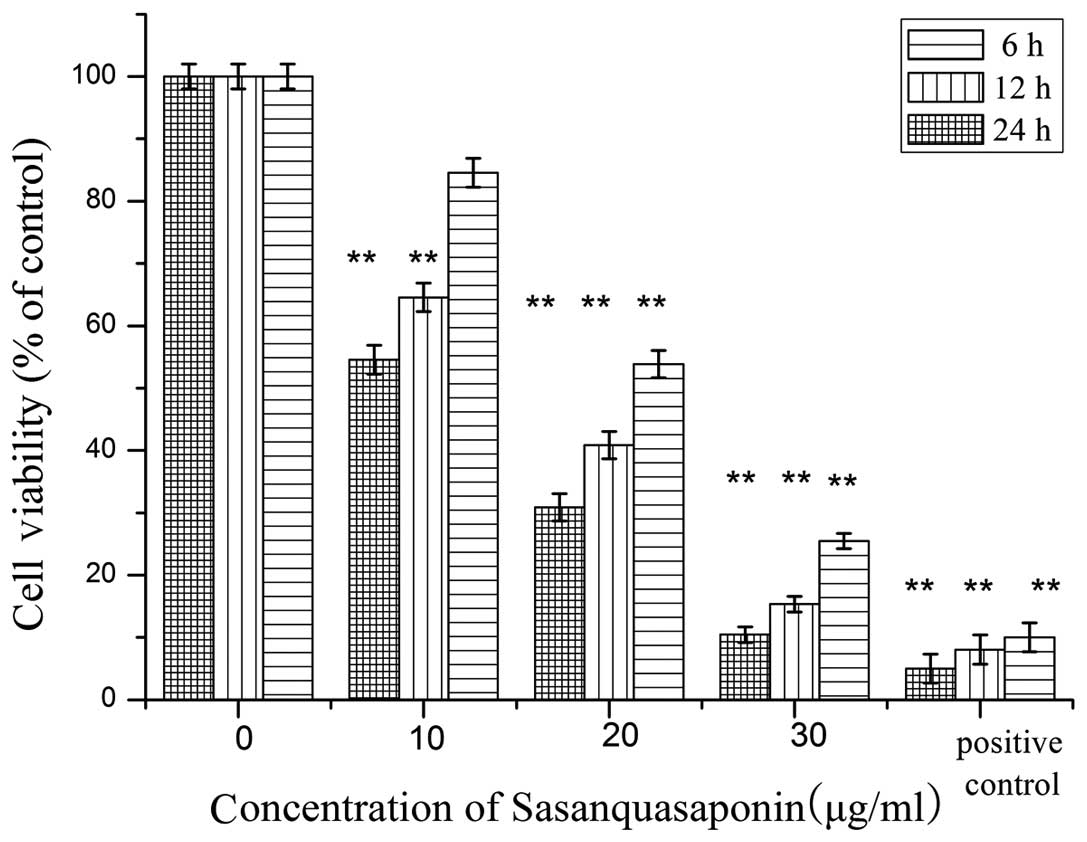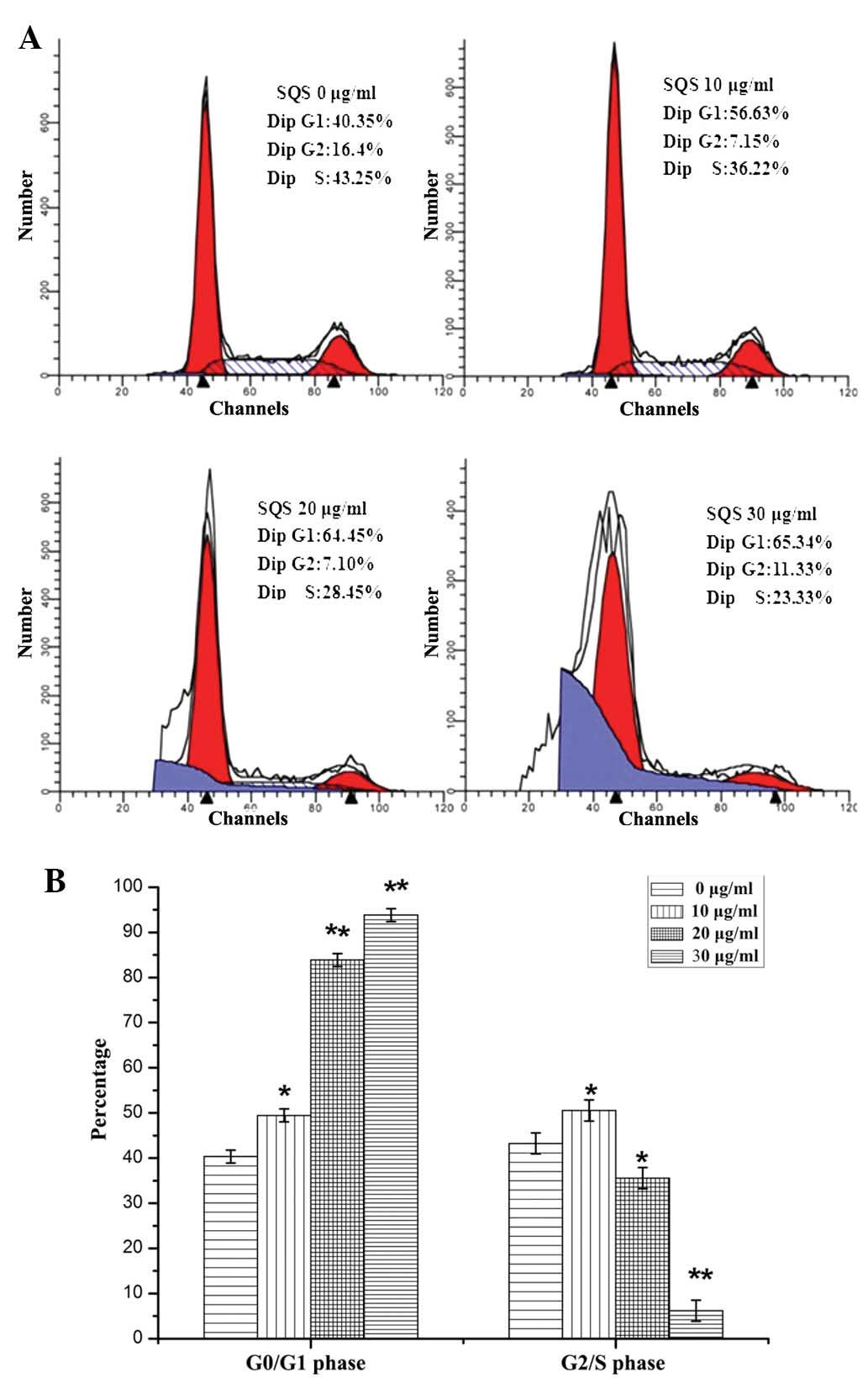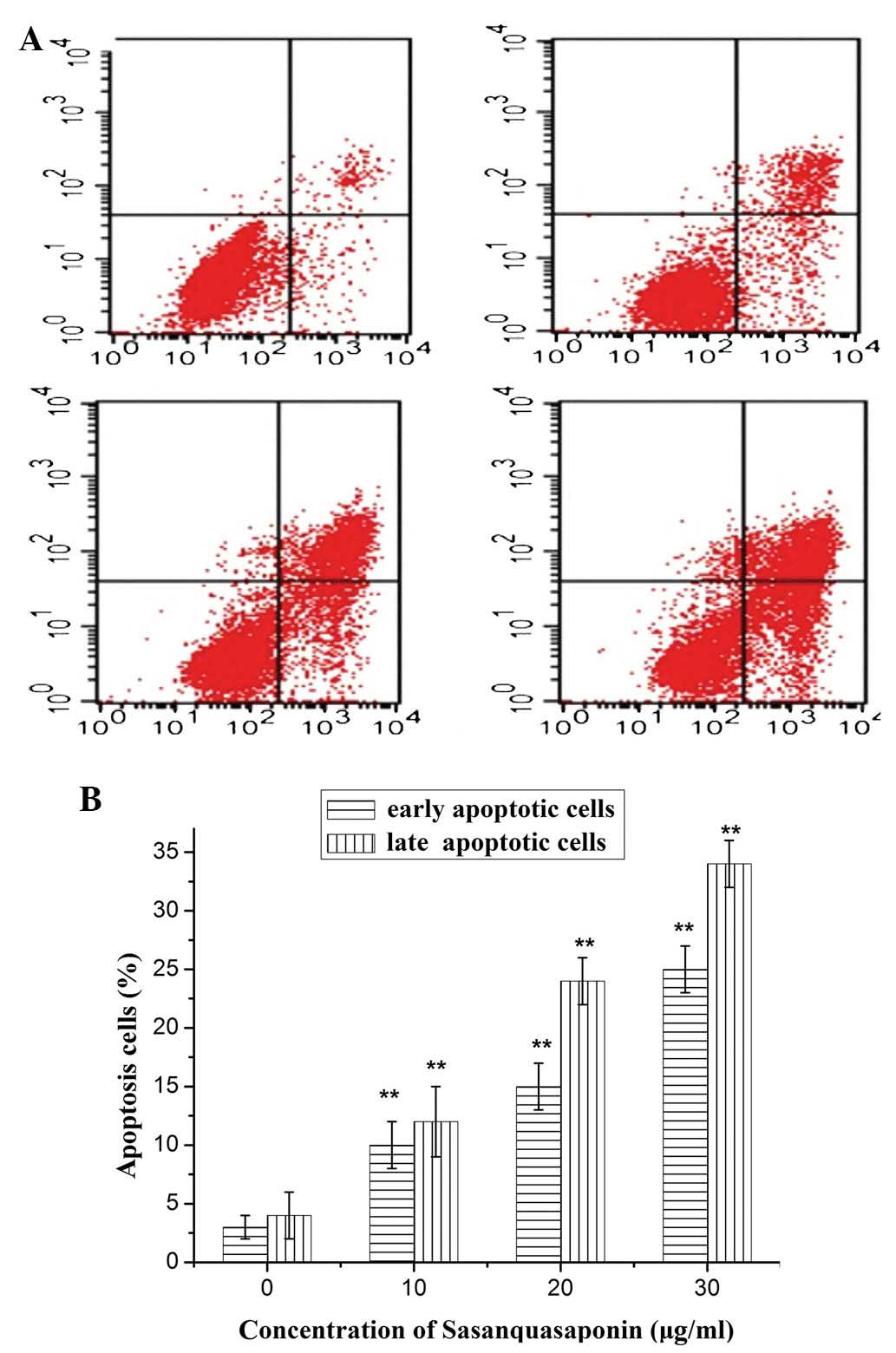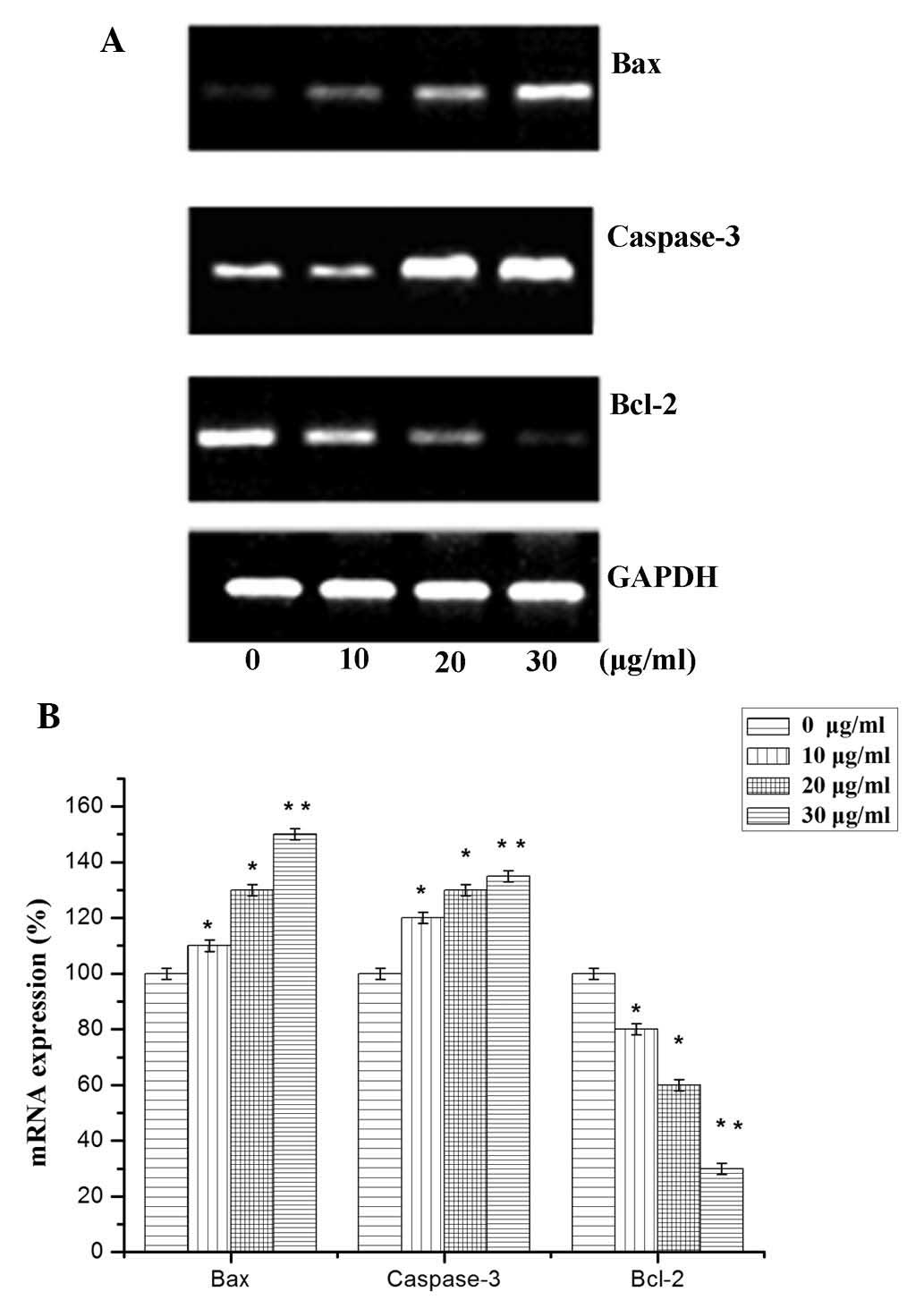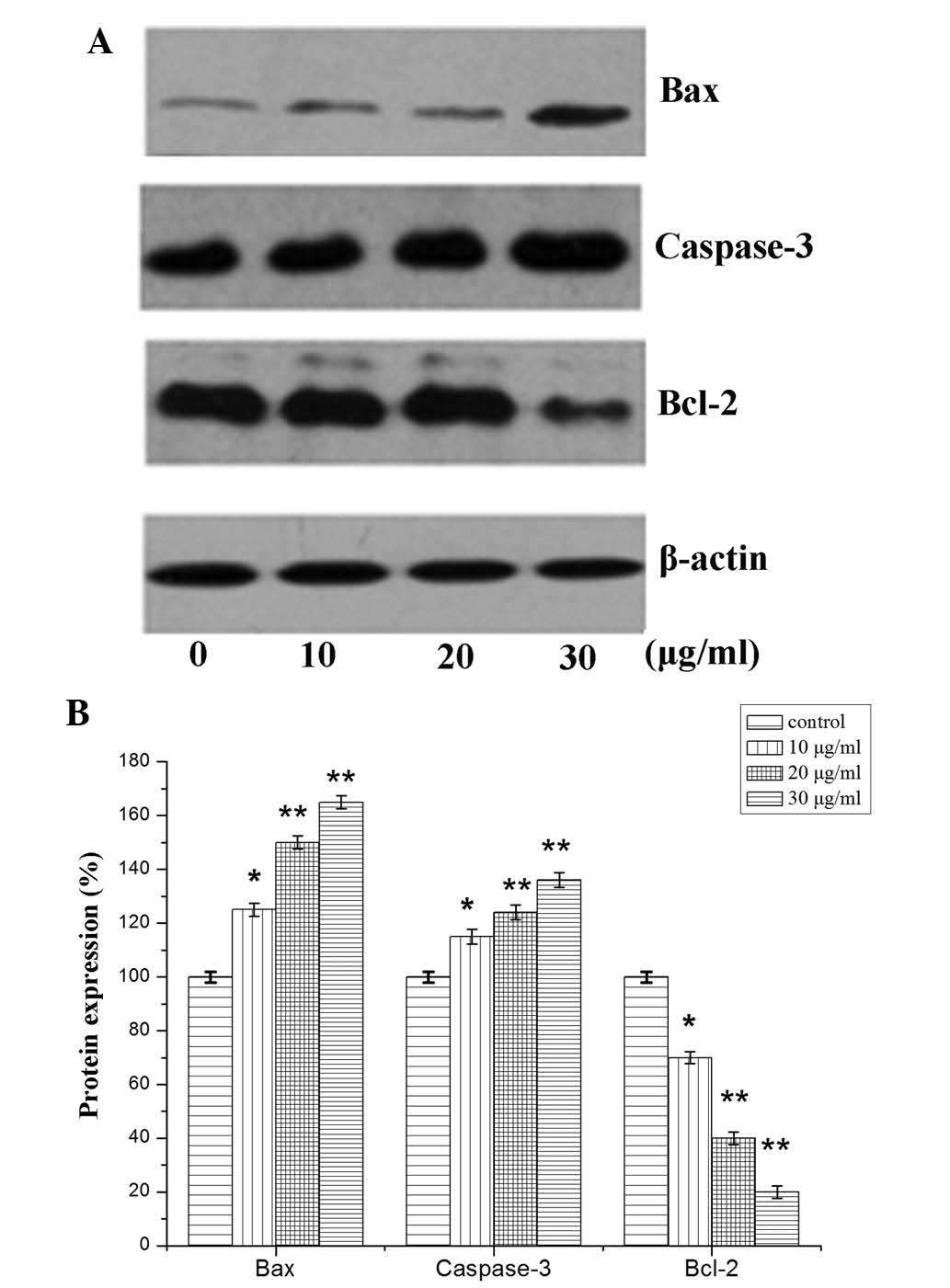Sasanquasaponin from Camellia oleifera Abel. induces apoptosis via Bcl-2, Bax and caspase-3 activation in HepG2 cells
- Authors:
- Published online on: April 23, 2015 https://doi.org/10.3892/mmr.2015.3666
- Pages: 1997-2002
Abstract
Introduction
Hepatocellular carcinoma (HCC) is the fifth most common and aggressive malignancy worldwide, accounting for >90% of all primary liver cancers and representing the third leading cause of liver cancer mortality (1). Annually, HCC is responsible for ~1 million mortalities worldwide (2). HCC is also known as adult primary liver cancer and develops from an abnormal mass of tumor nodules, metastasizing to adjoining parts of the liver and resulting in malignancy (3). An increasing body of evidence has suggested that >0.5 million novel cases of HCC are diagnosed annually (4). Patient prognoses following surgical resection of HCC remain poor due to the high rate of recurrence and dearth of effective adjuvant therapies (5). Tumor recurrence occurs in >70% of cases within five years (6), and the five-year survival rate is just 60–70%. The clinical therapies currently available require extensive immunosuppressive pre-treatments, which frequently result in undesirable physiological side-effects (7). The identification of patients with a higher risk of recurrence and the development of more effective and targeted therapeutic strategies are required in order to improve patient prognoses. Therefore, the development of novel therapeutic strategies for the treatment of HCC, with fewer adverse effects, is urgently required for the improvement of clinical practices and HCC patient prognosis.
Camellia oleifera (C. oleifera) Abel. is cultivated in numerous regions throughout China (8). C. oleifera seeds are used in the production of oil. Sasanquasaponin (SQS) is a biologically active ingredient, which may be extracted from C. oleifera Abel. SQS has numerous pharmacological properties, including anti-inflammatory, anti-hyperlipidemic and anti-effusive effects (9). Studies have revealed that SQS is able to induce apoptosis in human leukemia Jurkat cells and HepG2 hepatoma cells (10,11). The present study therefore aimed to determine whether SQS was able to induce cell cycle arrest and apoptosis in the HepG2 HCC cell line, and investigate the potential mechanisms underlying these effects.
Materials and methods
Materials and reagents
RPMI-1640, fetal bovine serum (FBS), penicillin-streptomycin, Trypsin-EDTA and TRIzol were obtained from Invitrogen Life Technologies (Carlsbad, CA, USA). SuperScript II reverse transcriptase was obtained from Promega Corp. (Madison, WI, USA). B-cell lymphoma 2 (Bcl-2), Bcl-2-associated x protein Bax and β-actin primary antibodies, as well as horseradish peroxidase-conjugated secondary antibodies were purchased from Cell Signaling Technology, Inc. (Danvers, MA, USA). 5-FU was obtained from Zhejian Wanma Pharm., Co. (Hangzhou, China). All other reagents, unless otherwise stated, were obtained from Sigma-Aldrich (St. Louis, MO, USA).
SQS drug preparation
Enrichment experiments were performed in glass columns (2.5×60 cm) packed with AB-8 (Shanghai Resin Factory Co., Ltd., Shanghai, China). C. olifeira was obtained from Sanming City, Fujian, China. A total of ~500 g seeds of C. olifeira were refluxed with 70% ethanol. The extracted solution was concentrated to 500 ml without ethanol. The ethanolic extract was adjusted to pH 5.0, and the sample flowed through the glass column at a rate of 1.0 bed volumes (BV)/h, while 0.1% NaOH solution was added via the separatory funnel, in order to elute impurities and pigment. Following clarification, the sample was sequentially eluted with distilled water to neutral, and then with 90% ethanol (Sinopharm Chemical Reagent Co., Ltd., Beijing, China) solution (containing 1% NaOH; Sinopharm Chemical Reagent Co., Ltd.) at a constant flow rate of 2.0 BV/h. Each fraction was collected and evaporated to remove the ethanol using a rotary evaporator (RE52AA; Yarong Equipment Co., Shanghai, China) under reduced pressure at 55°C. Subsequently, 500 ml acetone (Sinopharm Chemical Reagent Co., Ltd.) was added to the concentrated liquid and left to stand overnight, followed by centrifugation at 1,006 x g for 30 min. The sediment was dissolved in 70% ethanol, placed in the fridge at 4°C overnight, filtered and dried at 60°C to a constant weight (500 g) to produce high-purity SQS crystals (5 g) (12).
Cell culture and treatment
Immortalized HepG2 human hepatocellular carcinoma cells were obtained from the Live Cancer Institute of Zhongshan Hospital (Shanghai, China) and maintained in Dulbecco’s modified Eagle’s medium containing 10% FBS and 1% penicillin/streptomycin solution at 37°C in 5% CO2. All experiments were performed while the cells were in an exponential growth phase (13).
Cytotoxicity assay
HepG2 cells were seeded into standard 96-well culture plates at a density of 2.0×104 cells/well and cultured to ~70% confluence. Cells were maintained in medium containing various concentrations (0, 10, 20 or 30 µg/ml) of SQS and 30 µg/ml 5-FU for 6, 12 or 24 h prior to the addition of 20 µl MTT solution (5 mg/ml MTT) to each well and cultured for a further 4 h. The medium was subsequently removed and 150 µl/well dimethyl sulfoxide was added and incubated for 10 min whilst shaking gently to stop the reaction. The optical density (OD) at 570 nm was read using an ELISA reader (ELX800; BioTek Instruments, Inc., Winooski, VT, USA). Each independent experiment was performed in triplicate (14).
Cell apoptosis analysis
Annexin V staining (in the presence or absence of SQS) and cell scanning were conducted using an Annexin V-fluorescein isothiocyanate (FITC) detection kit (Beyotime Institute of Biotechnology, Haimen, China). The HepG2 cells were treated with 0, 10, 20 or 30 µg/ml SQS for 12 h. To detect apoptosis, 1×105 cells were resuspended in 500 µl binding buffer in the presence of 5 µl Annexin V-FITC and 5 µl propidium iodide and incubated at room temperature for 15 min in the dark. The fluorescence was measured using a FACScan flow cytometer (BD Bioscience) and the mean fluorescent intensity of triplicate samples for each SQS concentration cohort was used to ascertain the levels of Annexin V. The data were analyzed using CellQuest software version 1.0 (BD Biosciences, Franklin Lakes, NJ, USA) (15).
Cell cycle analysis
HepG2 cells were treated with 0, 10, 20 or 30 µg/ml SQS for 12 h. Subsequently, cells were harvested, washed with solution buffer and fixed in cold 70% ethanol overnight. A DNA content detection kit (Beyotime Institute of Biotechnology, Haimen, China) was used for cell cycle analysis. The cells were collected and suspended in 100 µl solution A and incubated at room temperature for 10 min. Analogous conditions were used upon the addition of 100 µl solution B and 150 µl solution C. Cell cycle progression was analyzed using a FACScan flow cytometer (BD Biosciences). The percentages of cells in G0/G1, S and G2/M phases were determined using ModFitLT software version 3.0 (Verity Software House, Topsham, ME, USA).
Reverse transcription-polymerase chain reaction (RT-PCR) and gene expression analysis
RT-PCR was performed as described previously (16). HepG2 cells were seeded into six-well plates at a density of 1×105 cells/well in 2 ml medium and treated with 0, 10, 20 or 30 µg/ml SQS for 12 h. Total RNA was isolated with TRIzol, and oligo (dT)-primed RNA (1 µg) was reverse-transcribed using SuperScript II reverse transcrip-tase (Promega Corp.) according to the manufacturer’s instructions. The obtained cDNA was used to determine the mRNA expression levels of Bcl-2, Bax and caspase-3 by PCR analysis. GAPDH was used as an internal control. The primer sequences used for the amplification of Bcl-2, Bax, caspase-3 and GAPDH were as follows: Bcl-2 for wa rd, 5′-TTCTCTCGTCGCTACCGTCGC-3′ and reverse, 5′-CCT CCCCCAGTTCACCCCATC-3′; Bax forward, 5′-CTTTTT GCTACAGGGTTTCA-3′ and reverse, 5′-CCATGTTGTTGT CCAGTTCAT-3′; caspase-3 forward, 5′-CAGAAGATACCA GTGGAGGCC-3′ and reverse, 5′-TTCCGGTTAACACGA GTGAGG-3′; GADPH forward, 5′-CGACCACTTTGTCA AGCTCA-3′ and reverse, 5′-AGGGGTCTACATGGCAA CTG-3′. All primers were synthesized by Sangon Biotech (Shanghai, China). The reaction included 1 µl cDNA, 2 µl 10X Taq Buffer, 1.2 µl 25 mM MgCl2, 0.4 µl 10 mM dNTP, 0.8 µl 1U/μL Taq polymerase, 1 µl each primer and DEPC water upto 20 µl. The PCR conditions were as follows: 95°C for 3 min and 30 cycles at 95°C for 30 sec, 56°C for 40 sec and 72°C for 40 sec. Samples were analyzed by 1.5% agarose gel electrophoresis. The DNA bands were evaluated using a Gel Documentation system (Gel Doc 2000; Bio-Rad Laboratories, Inc., Hercules, CA, USA).
Western blot analysis
HepG2 cells were seeded in culture dishes (2×105/well) and treated with 0, 10, 20 or 30 µg/ml SQS for 12 h. The cells were washed twice with phosphate-buffered saline (PBS) and lysed with lysis buffer according to the manufacturer’s instructions. The protein concentration of the lysate was determined via the bicinchoninic acid assay (Pierce, Rockford, IL, USA). Samples were analyzed using 10% SDS-PAGE (Dingguo Biotech., Fuzhou, China). Following electrophoresis, the proteins were transferred onto polyvinylidene difluoride membranes. The membranes were blocked with 5% skimmed milk in PBS with Tween 20 (PBST; Xilong Chemical Co., Ltd., Shantou, China) for 1.5 h and incubated with rabbit anti-Bcl-2, anti-Bax and anti-caspase-3 antibodies (1:1,000 dilution) at 4°C overnight. Following three washes with PBST buffer, the membranes were incubated with goat anti-rabbit immunoglobulin G conjugated with horseradish peroxidase for 2 h at room temperature. Following three washes with PBST, the protein bands were detected using enhanced chemiluminescence using Clarity Western Substrate (Bio-Rad, Hercules, CA, USA), according to the manufacturer’s instructions and images were captured using a ChemiDoc XRS+ system (Bio-Rad). β-actin was used as the control to confirm equal loading. Densitometry index analysis of the bands was conducted using a gel imagery system (17).
Statistical analysis
Values are presented as the mean ± standard deviation. Results were analyzed by one-way analysis of variance. When significant treatment effects were detected, Tukey-Kramer’s t-test was performed to make pairwise comparisons between individual means. Statistical analysis software SPSS 19.0 (International Business Machines, Armonk, NY, USA) was used to conduct statistical analyses. P<0.05 was considered to indicate a statistically significant difference.
Results
SQS reduces HepG2 cell viability
The MTT assay suggested that cytotoxic effects occurred 6, 12 and 24 h following incubation with SQS, even at doses as low as 20 µg/ml SQS. As indicated in Fig. 1, the degree of cytotoxicity was directly proportional to the concentration of SQS, suggesting a dose-dependent effect. The results of the MTT test indicated that following 6 h of incubation with 10, 20 or 30 µg/ml SQS, cell survival was reduced to 84.56, 53.86 and 25.25%, respectively.
SQS alters HepG2 cell cycle progression
The cell cycle has a key function in HepG2 cells, inducing their division and duplication. In addition, the G1/S-phase transition represents one of the major checkpoints used in the regulation of cell cycle progression. Once the cell cycle passes this checkpoint late in G1 phase, progression through the cell cycle continues with little or no extracellular stimuli (18). As indicated in Fig. 2, the proportion of cells in G0/G1 phase following treatment with 10, 20 or 30 µg/ml SQS was 56.63±1.76, 64.45±1.47 and 65.34±1.67%, a significantly higher proportion than that of untreated cells (40.35±1.33%; P<0.05). Concurrently, the percentage of cells in S phase following SQS treatment demonstrated the opposite trend. It was therefore suggested that SQS treatment may arrest cell cycle progression of HepG2 cells by inhibiting the G1 to S phase transition.
SQS induces apoptosis of HepG2 cells
To determine the mechanisms underlying the effects of SQS treatment on HepG2 cells, membrane alterations were analyzed by flow cytometry and double staining with Annexin V-FITC and PI. A progressive increase in the percentage of apoptotic cells was observed with increasing SQS concentration, which demonstrated the dose-dependent cytotoxicty of SQS to HepG2 cells (Fig. 3).
Expression levels of Bcl-2, Bax and caspase-3
Based on the aforementioned results, the association between the expression of apoptotic factors and SQS-induced apoptosis of HepG2 cells was investigated. The mRNA and protein expression levels of apoptosis-associated factors Bcl-2, Bax and caspase-3 were therefore evaluated (19). A significant reduction in Bcl-2 mRNA expression levels was observed following treatment with 10, 20 and 30 µg/ml SQS, compared with those in untreated cells (Fig. 4). Conversely, a significant increase in caspase 3 and Bax mRNA expression was observed. An analogous trend was observed in the protein expression levels of caspase-3, Bcl-2 and Bax following SQS treatment (Fig. 5).
Discussion
The results of the present study revealed that SQS inhibited human HepG2 hepatocellular carcinoma cell growth, indicated by a decrease in cell density following SQS treatment. Furthermore, the mRNA and protein expression levels of key apoptotic regulators Bax, Bcl-2 and caspase-3 were found to be altered following SQS treatment (20).
It has previously been demonstrated that the intracellular signaling pathways influenced by SQS and its metabolites are involved in the regulation of numerous cell signaling pathways, which contribute to the activation or inhibition of various cellular processes (21). SQS influences not only the transduction of signals from the extracellular space, but also functions as a mediator and modulator of intercellular and intracellular signaling networks (22–24).
The results of the present study indicated that pre-treatment of HepG2 cells with SQS resulted in Annexin V-positive staining. These results suggested that SQS may block the signal transduction pathway required for cell survival and induce HepG2 cell apoptosis. The mRNA and protein expression levels of Bcl-2, caspase-3 and Bax were therefore examined. Bax is a pro-apoptotic Bcl-2 protein, which contains BH1, BH2 and BH3 domains and initiates apoptotic signaling. The expression of Bax is upregulated by the tumor suppressor protein p53, and Bax has been shown to be involved in p53-mediated apoptosis. The results of the present study demonstrated that SQS treatment increased Bax expression in HepG2 cells. Caspase-3 is encoded by the CASP3 gene and interacts with caspase-8 and -9. In apoptotic cells, caspase-3 activation may occur via extrinsic (death ligand) or intrinsic (mitochondrial) pathways. Of note, Bax is involved in the intrinsic pathway. Activated caspase-3 induces caspase-8 activation and subsequently activates Bax, which stimulates cytochrome C and induces apoptosis (25). An identical signaling pathway was identified in the HepG2 cells evaluated in the present study. Caspase-3 activation was previously demonstrated to be increased following treatment of cells with SQS (26,27).
SQS interacts with mitochondrial membranes and alters their permeability by opening transition pores and decreasing the mitochondrial membrane potential (28). SQS therefore induces structural changes and increases mitochondrial membrane unsaturation.
These mitochondrial alteration may influence the activity of pro- and anti-apoptotic proteins of the Bcl-2 family. It was previously demonstrated that SQS contributes to the down-regulation of Bcl-2 expression, a well-known anti-apoptotic molecule, and blocks lipid peroxidation; therefore, inhibiting the induction of apoptosis (29). The results of the present study indicated that SQS suppressed Bcl-2 expression.
Based on previously published studies and the results of the present study, it was hypothesized that SQS induces human hepatocellular carcinoma cell apoptosis. The signal transduction occurs via the caspase-3 signaling pathway. Further study on this signaling pathway is required to elucidate the function of SQS in tumor invasion and survival.
Acknowledgments
The present study was supported by the Key Projects Science Foundation of Fujian province (grant no. 2011J05073) and the Natural Science Foundation of Fujian Province (grant no. 2011J05073).
References
|
Evan GI and Vousden KH: Proliferation, cell cycle and apoptosis in cancer. Nature. 411:342–348. 2001. View Article : Google Scholar : PubMed/NCBI | |
|
Jemal A, Bray F, Center MM, et al: Global cancer statistics. CA Cancer J Clin. 61:69–90. 2011. View Article : Google Scholar : PubMed/NCBI | |
|
Liu Y, Liu A, Xu Z, et al: XZH-5 inhibits STAT3 phosphorylation and causes apoptosis in human hepatocellular carcinoma cells. Apoptosis. 3:502–510. 2011. View Article : Google Scholar | |
|
Ercolani G, Grazi GL, Ravaioli M, et al: Liver resection for hepatocellular carcinoma on cirrhosis: Univariate and multivariate analysis of risk factors for intrahepatic recurrence. Ann Surg. 237:536–543. 2003. View Article : Google Scholar : PubMed/NCBI | |
|
Zhong W, Peng J, He H, et al: Ki-67 and PCNA expression in prostate cancer and benign prostatic hyperplasia. Clin Invest Med. 31:E8–E15. 2008.PubMed/NCBI | |
|
Longley DB, Allen WL and Johnston PG: Drug resistance, predictive markers and pharmacogenomics in colorectal cancer. Biochim Biophys Acta. 1766:184–196. 2006.PubMed/NCBI | |
|
Pizova K, Tomankova K, Daskova A, et al: Photodynamic therapy for enhancing antitumour immunity. Biomed Pap Med Fac Univ Palacky Olomouc Czech Repub. 156:93–102. 2012. View Article : Google Scholar : PubMed/NCBI | |
|
Zhang XF, Han YY, Bao GH, et al: A new saponin from tea seed pomace (Camellia oleifera Abel.) and its protective effect on PC12 cells. Molecules. 17:11721–11728. 2012. View Article : Google Scholar : PubMed/NCBI | |
|
Sagesaka YM, Uemura T, Suzuki Y, et al: Antimicrobial and anti-inflammatory actions of tea-leaf saponin. Yakugaku Zasshi. 116:238–243. 1996.In Japanese. PubMed/NCBI | |
|
Ma LY, Li L, Jiang Y, et al: Study on Youchasaponin-induced apoptosis of HepG2 cells through the endoplasmic reticulum stress. Chin Pharmacol Bull. 27:1523–1527. 2011. | |
|
Ma LY, Li L, Jiang Y, et al: Youchasaponin induces apoptosis of human leukemia Jurkat cells in vitro and its possible mechanism. Tumor. 31:1072–1076. 2011. | |
|
Yang JJ, Hsu HY, Ho YH and Lin CC: Comparative study on the immunocompetent activity of three different kinds of Peh- Hue-Juwa-Chi-Cao, Hedyotis diffusa, H. corymbosa and Mollugo pentaphylla after sublethal whole body X-irradiation. Phytother Res. 11:428–432. 1997. View Article : Google Scholar | |
|
Lin JM, Wei LH, Xu W, et al: Effect of Hedyotis diffusa Willd extract on tumor angiogenesis. Mol Med Rep. 4:1283–1288. 2011.PubMed/NCBI | |
|
Boos G and Stopper H: Genotoxicity of several clinically used topoisomerase II inhibitors. Toxicol Lett. 116:7–16. 2000. View Article : Google Scholar : PubMed/NCBI | |
|
Kelloff GJ: Perspectives on cancer chemoprevention research and drug development. Adv Cancer Res. 78:199–334. 2000. | |
|
Singh S, Johnson J and Chellappan S: Small molecule regulators of Rb-E2F pathway as modulators of transcription. Biochim Biophys Acta. 1799:788–794. 2010. View Article : Google Scholar : PubMed/NCBI | |
|
Shortkroff S and Yates KE: Alteration of matrix glycosami-noglycans diminishes articular chondrocytes’ response to a canonical Wnt signal. Osteoarthritis Cartilage. 15:147–154. 2007. View Article : Google Scholar | |
|
Chen Y, Robles AI, Martinez LA, et al: Expression of G1 cyclins, cyclin-dependent kinases, and cyclin-dependent kinase inhibitors in androgen-induced prostate proliferation in castrated rats. Cell Growth Differ. 7:1571–1578. 1996.PubMed/NCBI | |
|
Graña X and Reddy EP: Cell cycle control in mammalian cells: role of cyclins, cyclin dependent kinases (CDKs), growth suppressor genes and cyclin-dependent kinase inhibitors (CKIs). Oncogene. 11:211–219. 1995.PubMed/NCBI | |
|
Chen HP, He M, Mei ZJ, et al: Sasanquasaponin up-regulates anion exchanger 3 expression and elicits cardioprotection via NO/RAS/ERK1/2 pathway. Can J Physiol Pharmacol. 90:873–880. 2012. View Article : Google Scholar : PubMed/NCBI | |
|
Aszodi A, Hunziker EB, Brakebusch C and Fässler R: Beta1 integrins regulate chondrocyte rotation, G1 progression, and cytokinesis. Genes Dev. 17:2465–2479. 2003. View Article : Google Scholar : PubMed/NCBI | |
|
Li R, Zhao HR and Lin YM: Anti-tumor effect and protective effect on chemotherapeutic damage of water soluble extracts from Hedyotis diffusa. J Chin Pharm Sci. 11:54–58. 2002. | |
|
Lin J, Chen Y, Wei L, et al: Hedyotis diffusa Willd extract induces apoptosis via activation of the mitochondrion-dependent pathway in human colon carcinoma cells. Int J Oncol. 37:1331–1338. 2010.PubMed/NCBI | |
|
Handayani T, Sakinah S, Nallappan M, et al: Regulation of p53-, Bcl-2 and caspase-dependent signaling pathway in xanthor-rhizol-induced apoptosis of HepG2 hepatoma cells. Anticancer Res. 27:965–971. 2007.PubMed/NCBI | |
|
Lee HP, Chen YL, Shen HC, Lo WH and Hu YC: Baculovirus transduction of rat articular chondrocytes: roles of cell cycle. J Gene Med. 9:33–43. 2007. View Article : Google Scholar | |
|
Löwenheim H, Reichl J, Winter H, et al: In vitro expansion of human nasoseptal chondrocytes reveals distinct expression profiles of G1 cell cycle inhibitors for replicative, quiescent, and senescent culture stages. Tissue Eng. 11:64–75. 2005. View Article : Google Scholar : PubMed/NCBI | |
|
Chen L, Chen J and Xu H: Sasanquasaponin from Camellia oleifera Abel. induces cell cycle arrest and apoptosis in human breast cancer MCF-7 cells. Fitoterapia. 84:123–129. 2013. View Article : Google Scholar | |
|
Harper JW, Elledge SJ, Keyomarsi K, et al: Inhibition of cyclin-dependent kinases by p21. Mol Biol Cell. 6:387–400. 1995. View Article : Google Scholar : PubMed/NCBI | |
|
Hwang SG, Song SM, Kim JR, et al: Regulation of type II collagen expression by cyclin-dependent kinase 6, cyclin D1, and p21 in articular chondrocytes. IUBMB Life. 59:90–98. 2007. View Article : Google Scholar : PubMed/NCBI |



